Art & Exhibitions
True Craftsmanship Takes Center Stage at Venice’s Homo Faber—But Is It Being Watered Down by Luxury Brands?
Luca Guadagnino's striking scenography does little to distract from the question.
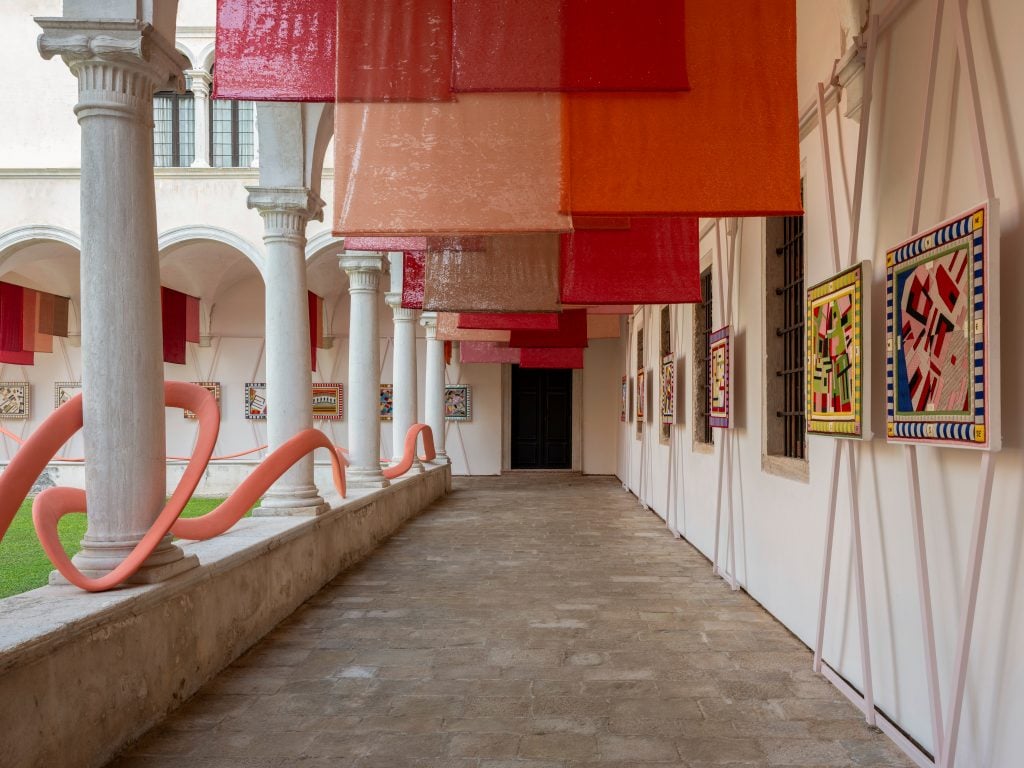
Luca Guadagnino, the Italian director of films including Call Me by Your Name and Challengers, is a busy man. His new movie, Queer, based on the novel by William S. Burroughs and starring Daniel Craig, premieres on September 3 at the Venice Film Festival. Another, a #MeToo-themed film set in academia and starring Julia Roberts, is currently being shot at Shepperton Studios. Last month, he was in Rome for the opening of a new five-star hotel— the Palazzo Talia. That’s another kind of Guadagnino production: he set up an interior design studio in 2017 and has already furnished a number of World of Interiors-worthy homes.
He also found time this year to create the scenography for Homo Faber—a huge show of contemporary craft at Venice’s Fondazione Cini that opened on September 1. “I wanted to envelop the audience, through the amazing architecture of the Fondazione” said the director at the end of last week, while crediting co-collaborator architect Nicolo Rosmarini. who works at his design studio.
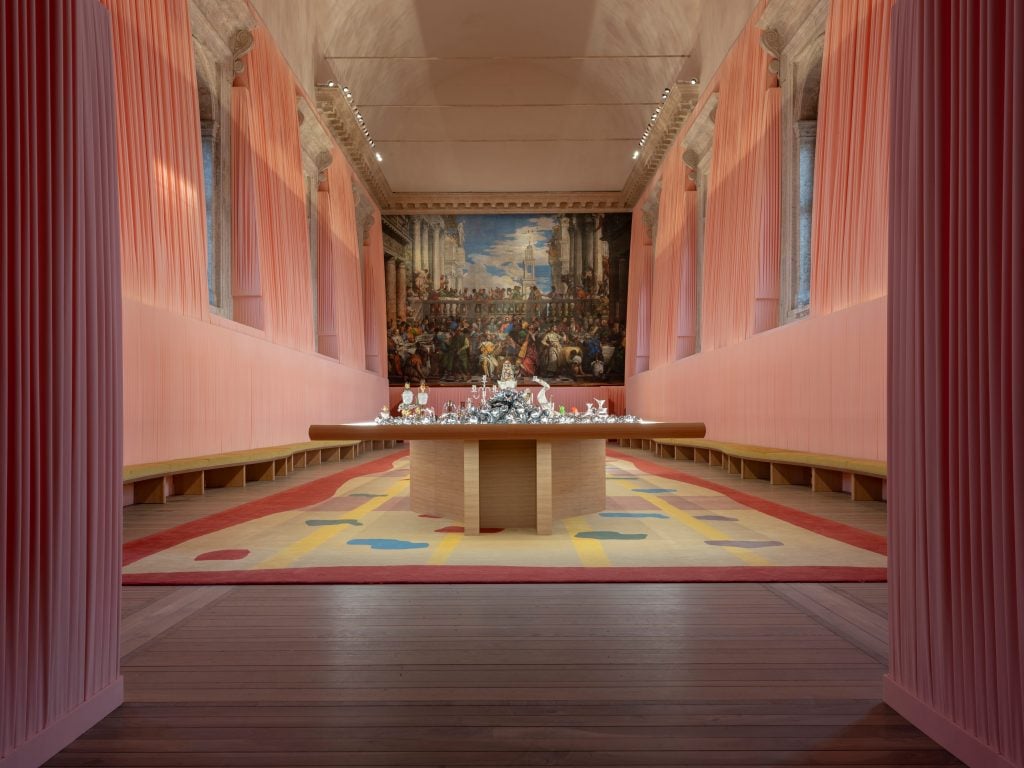
Celebration. Homo Faber 2024. Photo:Giulio Ghirardi ©Michelangelo Foundation.
Envelop the audience, he most certainly does. Taking his cue from the revered Venetian architect Carlo Scarpa, he has lined several of the Fondazione’s large halls (it was originally built as a Benedictine monastery) with floor-to-ceiling pleated velvet. (Scarpa did this in Messina in 1953 for an exhibition.) One room has a bespoke 23 meters-long mirrored table that groans with crystal and silver. Another is so dark, assistants have to guide visitors across the uneven parts of the floor.
As you might expect, he is a master of atmosphere. Though his assertion that, “I wanted to ensure the craft wouldn’t be overwhelmed,”—well, that’s up for discussion.
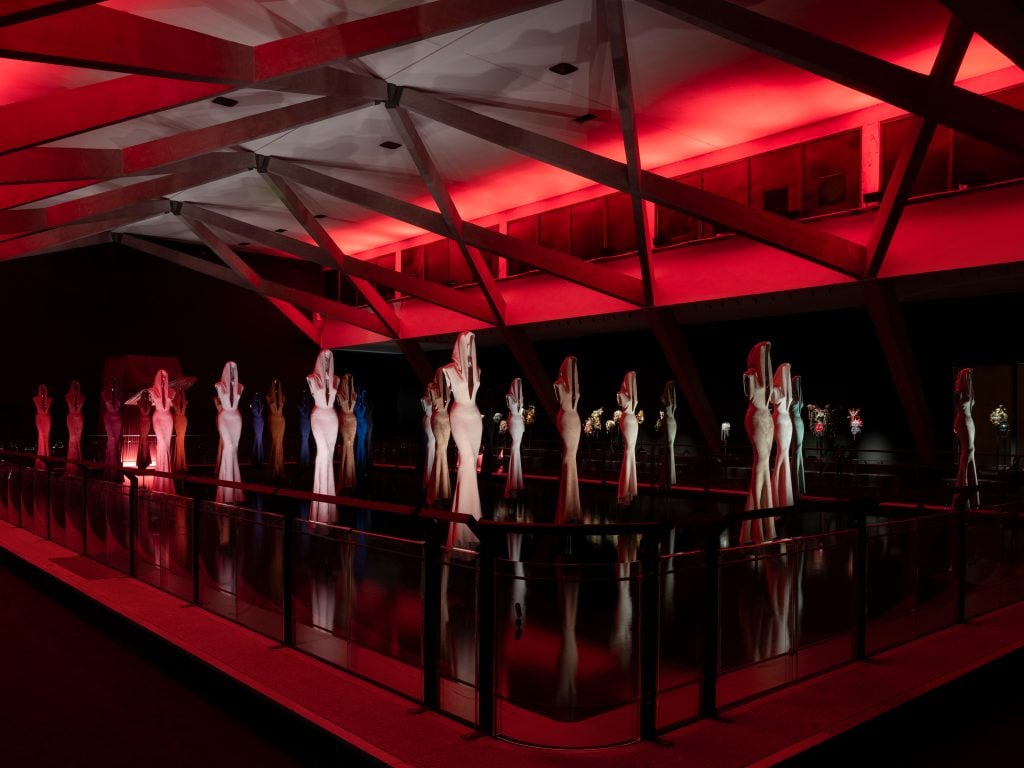
Dreams. Homo Faber 2024. Photo:Giulio Ghirardi ©Michelangelo Foundation.
This is the third edition of the biannual Homo Faber (or Man the Maker), which is organized by the nonprofit, Geneva-based Michelangelo Foundation. Its rhetoric runs around the edifying, human, emotional significance of craft; of the importance of beauty as a ultimate marker of civilization. Previous editions were relatively restrained Europe-focused affairs—though 2022’s threw a spotlight on Japan in a bid to become more international. The latest is simply unbridled. There are more than 800 exhibits by 400 artisans from 70 countries and they often rub up against each other in close and confusing proximity.
This year, the Foundation’s vice-chair, Hanneli Rupert, has stepped in. She is the daughter of Johann Rupert, the South African billionaire who is the founder of the Richemont group, which owns 28 luxury houses from Cartier to Panerai. Richemont is also the supporter of the foundation. Rupert introduced a narrative theme—”The Journey of Life”—with ten exhibition spaces taking visitors from “Birth” to “the Afterlife” (“Death” was presumably considered a bit too brutal), and objects have been corralled into each.
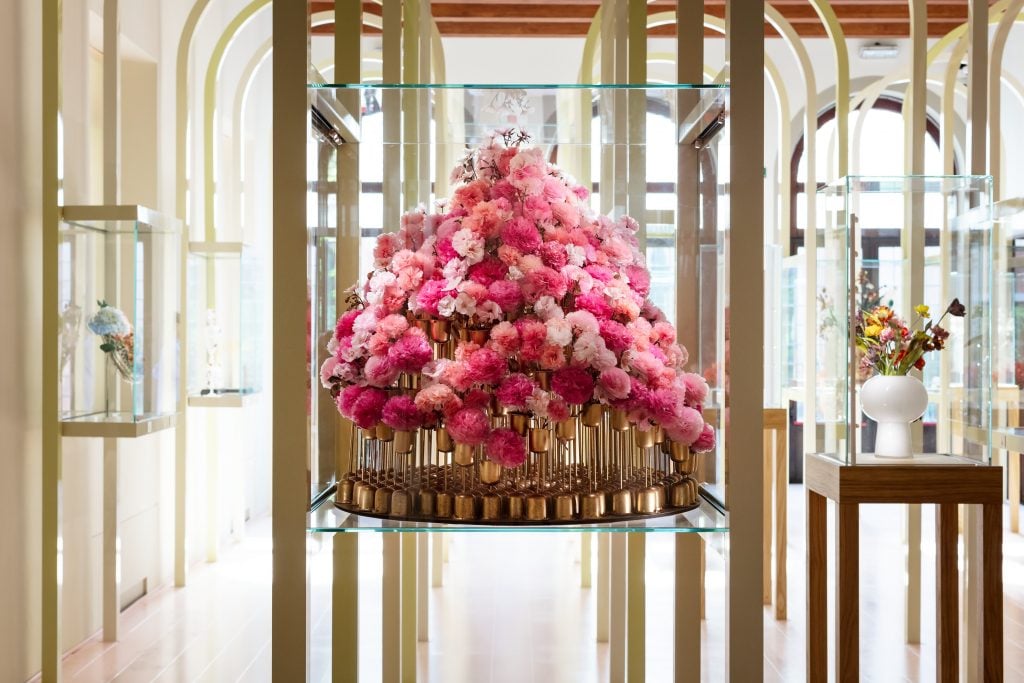
William Amor Theater of Metamorphosis – Bouquet of Roses. Love. Homo Faber 2024. Photo:Alexandre Vazquez ©Michelangelo Foundation.
The first part of a section called “Love,” for example, is a room dedicated to courtship, where 20 individual vitrines display bouquets of flowers made from materials ranging from the finest unglazed porcelain (Anna Volkova) to waste plastic from a Lancôme factory (William Amor). It’s a masterclass in creativity and virtuosity.
On the other hand, to place Fernando Laposse’s “Beast” stool, whose covering of blonde agave sisal “hair” gives it an animalistic quality, in a room dedicated to “Childhood”, is a reductive shame. The Mexican artist works with a collective of 45 Mayan women to create the agave fiber in a project as much about politics as production, addressing issues of female empowerment and sustainability. The result might appear playful, but Laposse’s “Beast” is neither a toy nor children’s furniture.
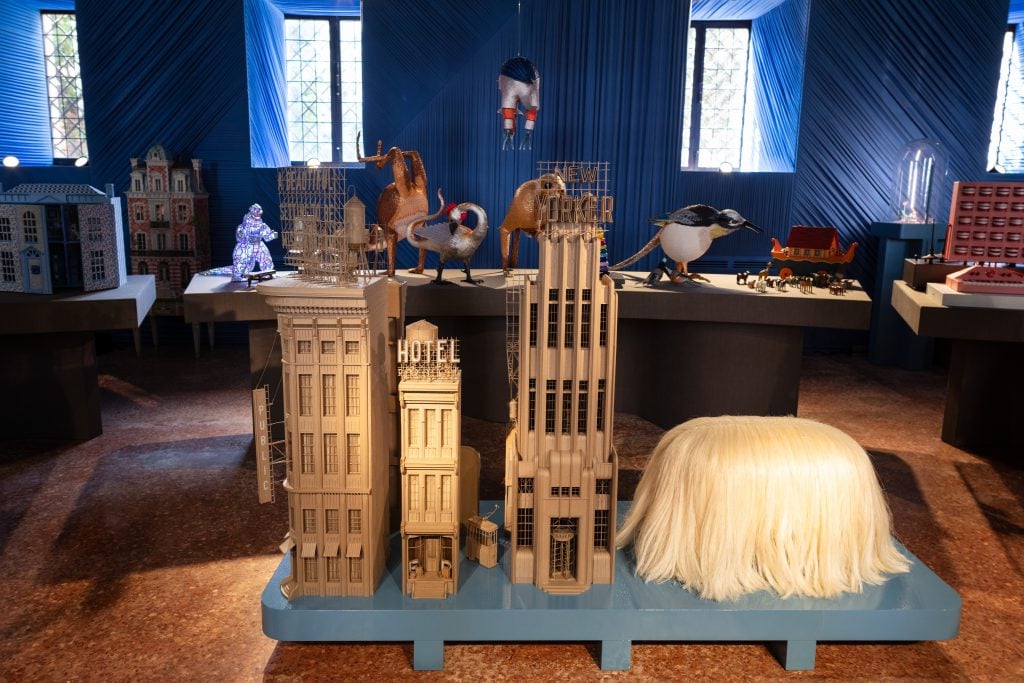
Childhood. Homo Faber 2024. Photo:Giulio Ghirardi ©Michelangelo Foundation.
While Richemont doesn’t directly advertise its presence here, it is everywhere. Hanneli Rupert made her introduction to the show dressed in (Richemont-owned) Chloé; in every room there are artisans from the Richemont stable—Van Cleef & Arpels, Cartier, Jaeger leCoultre—demonstrating the techniques required to fashion those house’s designs. The aforementioned mirrored table is heaped at one end with Buccellati’s glittering silver artichokes. Is this craft? It might require the same skills, but these luxury products fly on the coat-tails of huge marketing machines pumping out messages around heritage and class; their status is associated with cost first.
Individual makers don’t have PR people or cinema advertising. They often work alone and live on the tiniest of incomes. They are driven to create through a love of making; a lust for a chosen material; the compulsion that comes from getting better every time. The value of their work lies in uniqueness and time.
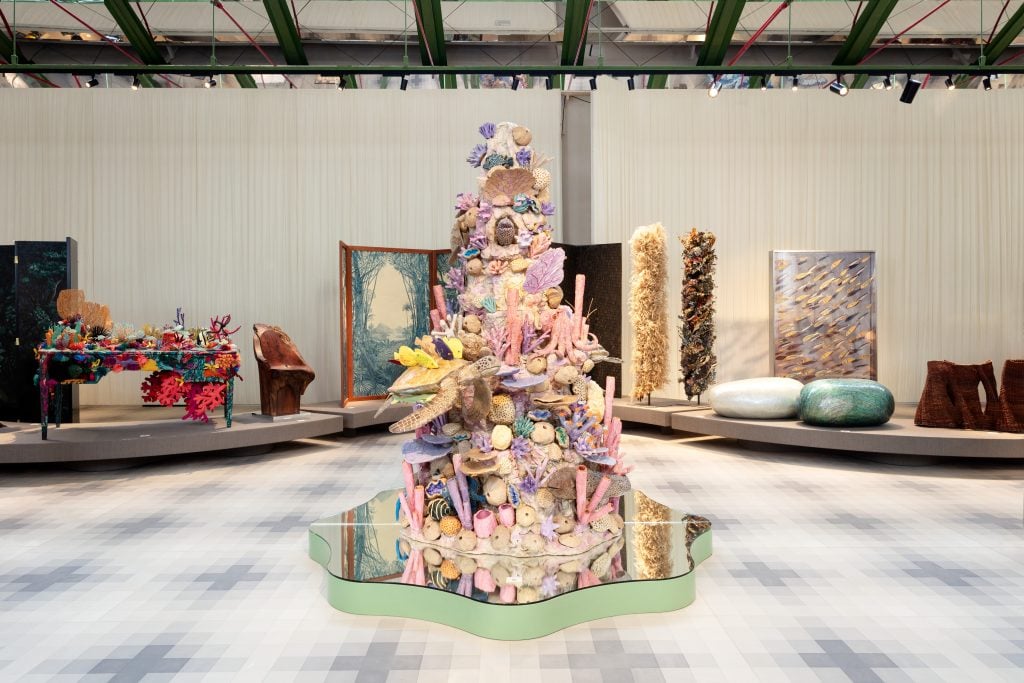
Josh Glukstein, Reef. Nature. Homo Faber 2024. Photo: Alexandre Vazquez ©Michelangelo Foundation.
Here it is subjected to some peculiar juxtapositions, too. In a room, called “Inheritance,” a pair of Moon jars by the South Korean mother-of-pearl specialist Jian Yoo are to be found in the company of fine leather riding boots by Artesania Muñoz of Toledo, Spain, and taps by the high-end French bathroom company Volevatch (very nice taps, but really?). At times, Homo Faber starts to feel like a flashy department store offering up a disparate load of left-over stock at the start of a Summer Sale. Sales, meanwhile, are being conducted through Via Arno, a freshly-minted Richemont-owned digital platform, established to sell “the world’s best craftsmanship.”
Nonetheless, for visitors prepared to put in the effort, there are many moments of joy. A double leaf stool in cast bronze by Belgian artist Clothilde Ancarani is a delicate homage to her country’s art deco heritage. A sublime glass bowl balancing on an explosive sculpture of Apollo and Daphne by lamp-working maestro Lucio Bubacco is a lesson in perfection and bravura in the glass making field. There are finely crafted leather whips by Mary Wing To, made of 12 strands of red and black kangaroo lace with sterling silver collars, and a sculpture of clear plastic masks by Filipino Leeroy New. During the Covid pandemic, in the Philippines, people had to create their own protection, and made face shields from plastic bottles. New is celebrating the ingenuity, as well as the precarity, of his people along with the possibilities of materials. You couldn’t make a face mask with a Buccellati artichoke.
Homo Faber is at Fondazione Cini, Venice, until September 30.





